12-Vertex closo-3,1,2-Ruthenadicarbadodecaboranes with Chelate POP-Ligands: Synthesis, X-ray Study and Electrochemical Properties
Abstract
:1. Introduction

2. Results
2.1. Synthesis of Novel Ruthenacarboranes
2.2. Electrochemical Studies
2.3. Catalysis of Radical Polymerization
2.4. DFT Studies of the Complexes
2.5. The Studies of Transformations of DPEphos-Based Complexes
3. Materials and Methods
3.1. General Considerations
3.2. Synthesis of Novel Ruthenacarboranes
3.3. X-ray Diffraction Study
3.4. Quantum-Chemical Calculations
3.5. Polymerization Procedure
4. Conclusions
Supplementary Materials
Author Contributions
Funding
Data Availability Statement
Acknowledgments
Conflicts of Interest
References
- Lorandi, F.; Matyjaszewski, K. Why do we need more active ATRP catalysts? Isr. J. Chem. 2019, 60, 108–123. [Google Scholar] [CrossRef] [Green Version]
- Bultz, E.; Ouchi, M.; Sawamoto, M.; Cunningham, M.F. “Smart” catalysis with thermoresponsive ruthenium catalysts for miniemulsion ru-mediated reversible deactivation radical polymerization cocatalyzed by smart iron cocatalysts. J. Polym. Sci. A Polym. Chem. 2019, 57, 305–312. [Google Scholar] [CrossRef]
- Grishin, I.D.; Zimina, A.M.; Anufriev, S.A.; Knyazeva, N.A.; Piskunov, A.V.; Dolgushin, F.M.; Sivaev, I.B. Synthesis and Catalytic Properties of Novel Ruthenacarboranes Based on nido-[5-Me-7,8-C2B9H10]2− and nido-[5,6-Me2-7,8-C2B9H9]2− Dicarbollide Ligands. Catalysts 2021, 11, 1409. [Google Scholar] [CrossRef]
- Zimina, A.M.; Knyazeva, N.A.; Balagurova, E.V.; Dolgushin, F.M.; Somov, N.V.; Vorozhtsov, D.L.; Malysheva, Y.B.; Grishin, I.D. Revising the chemistry of κ2-dppe-closo-RuC2B9H11 fragment: Synthesis of novel diamagnetic complexes and its transformations. J. Organomet. Chem. 2021, 946–947, 121908. [Google Scholar] [CrossRef]
- Penkal, A.M.; Somov, N.V.; Shchegravina, E.S.; Grishin, I.D. Ruthenium Diphosphine Closo-C2B9-Carborane Clusters with Nitrile Ligands: Synthesis and Structure Determination. J. Clust. Sci. 2019, 30, 1317–1325. [Google Scholar] [CrossRef]
- Penkal, A.M.; D’yachihin, D.I.; Somov, N.V.; Shchegravina, E.S.; Grishin, I.D. Synthesis of novel closo -carborane complexes of ruthenium (II) with triphenylphosphine or acetonitrile ligands via reduction of paramagnetic Ru(III) derivatives. J. Organomet. Chem. 2018, 872, 63–72. [Google Scholar] [CrossRef]
- D’yachikhin, D.I.; Grishin, I.D.; Dolgushin, F.M.; Godovikov, I.A.; Chizhevsky, I.T.; Grishin, D.F. Synthesis, isomerism, and catalytic properties of chelate ruthenium copper bimetallacarborane cluster exo-closo-(Ph3P)Cu(μ-H)Ru[Ph2P(CH2)4PPh2](η5-C2B9H11), in radical polymerization of methyl methacrylate. Russ. Chem. Bull. 2010, 59, 1145–1151. [Google Scholar] [CrossRef]
- Higashi, S.; Takenaka, H.; Ito, Y.; Oe, Y.; Ohta, T. Synthesis of RuCl2(xantphos)L (L = PPh3, P(OPh)3, DMSO) Complexes, and their Catalytic Activity for the Addition of Carboxylic Acids onto Olefins. J. Organomet. Chem. 2015, 791, 46–50. [Google Scholar] [CrossRef]
- Adams, G.M.; Weller, A.S. POP-type ligands: Variable coordination and hemilabile behaviour. Coord. Chem. Rev. 2018, 355, 150–172. [Google Scholar] [CrossRef]
- Takahashi, K.; Yamashita, M.; Nozaki, K. Tandem Hydroformylation/Hydrogenation of Alkenes to Normal Alcohols Using Rh/Ru Dual Catalyst or Ru Single Component Catalyst. J. Am. Chem. Soc. 2012, 134, 18746–18757. [Google Scholar] [CrossRef]
- Venkateswaran, R.; Mague, J.T.; Balakrishna, M.S. Ruthenium(II) Complexes Containing Bis(2-(diphenylphosphino)phenyl) Ether and Their Catalytic Activity in Hydrogenation Reactions. Inorg. Chem. 2007, 46, 809–817. [Google Scholar] [CrossRef] [PubMed]
- Deb, B.; Borah, B.J.; Sarmah, B.J.; Das, B.; Dutta, D.K. Dicarbonylruthenium(II) complexes of diphosphine ligands and their catalytic activity. Inorg. Chem. Commun 2009, 12, 868–871. [Google Scholar] [CrossRef]
- Grishin, I.D.; D’yachihin, D.I.; Piskunov, A.V.; Dolgushin, F.M.; Smolyakov, A.F.; Il’in, M.M.; Davankov, V.A.; Chizhevsky, I.T.; Grishin, D.F. Carborane complexes of ruthenium(III): Studies on thermal reaction chemistry and the catalyst design for atom transfer radical polymerization of methyl methacrylate. Inorg. Chem. 2011, 50, 7574–7585. [Google Scholar] [CrossRef] [PubMed]
- Grishin, I.D.; D’yachihin, D.I.; Turmina, E.S.; Dolgushin, F.M.; Smol’yakov, A.F.; Piskunov, A.V.; Chizhevsky, I.T.; Grishin, D.F. Mononuclear closo-ruthenacarborane complexes containing a rare eight-membered metal-diphosphine ring. J. Organomet. Chem. 2012, 721–722, 113–118. [Google Scholar] [CrossRef]
- Jones, J.J.; English, L.E.; Robertson, A.P.M.; Rosair, G.M.; Welch, A.J. Mixed-ligand (triphenylphosphine)ruthenium complexes of diphenylcarborane by ligand manipulation and an asymmetric, bimolecular “symbiotic” cluster. J. Organomet. Chem. 2018, 865, 65–71. [Google Scholar] [CrossRef]
- Stogniy, M.Y.; Erokhina, S.A.; Suponitsky, K.Y.; Markov, V.Y.; Sivaev, I.B. Synthesis and crystal structures of nickel(II) and palladium(II) complexes with o-carboranyl amidine ligands. Dalton Trans. 2021, 50, 4967–4975. [Google Scholar] [CrossRef]
- Tutusaus, O.; Vinas, C.; Nunez, R.; Teixidor, F.; Demonceau, A.; Delfosse, S.; Noels, A.F.; Mata, I.; Molins, E. The modulating possibilities of dicarbollide clusters: optimizing the Kharasch catalysts. J. Am. Chem. Soc. 2003, 125, 11830–11831. [Google Scholar] [CrossRef]
- Teixeira, R.G.; Marques, F.; Robalo, M.P.; Fontrodona, X.; Garcia, M.H.; Crich, G.S.; Vinas, C.; Valente, A. Ruthenium carboranyl complexes with 2,2′-bipyridine derivatives for potential bimodal therapy application. RSC Adv. 2020, 10, 16266–16276. [Google Scholar] [CrossRef] [Green Version]
- Van der Veen, L.A.; Keeven, P.H.; Schoemaker, G.C.; Reek, J.N.H.; Kamer, P.C.J.; van Leeuwen, P.W.N.M.; Lutz, M.; Spek, A.L. Origin of the Bite Angle Effect on Rhodium Diphosphine Catalyzed Hydroformylation. Organometallics 2000, 19, 872–883. [Google Scholar] [CrossRef]
- Kostukovich, A.Y.; D’yachihin, D.I.; Dolgushin, F.M.; Smol’yakov, A.F.; Godovikov, I.A.; Chizhevsky, I.T. An Unusual Conversion of Paramagnetic [3-Cl-3,3,8-{Ph2P(CH2)nPPh-μ-(C6H4-ortho)}-1,2-(CH3)2-closo-3,1,2-RuIIIC2B9H8] (n = 3 and 4) to Form the First 18-Electron P-Phenylene ortho-Cycloboronated closo-Ruthenacarboranes with a Dioxygen Ligand. Molecules 2014, 19, 7094–7103. [Google Scholar] [CrossRef]
- Kirchner, K.; Mauthner, K.; Mereiter, K.; Schmid, R. Irreversible binding of dioxygen and other gases to a half-sandwich ruthenium(II) complex: X-ray structure of [Ru(η2-O2)(η5-C5Me5)(Ph2PCH2CH2PPh2)]PF6. J. Chem. Soc. Chem. Commun. 1993, 11, 892–894. [Google Scholar] [CrossRef]
- Chizhevsky, I.T.; Lobanova, I.A.; Bregadze, V.I.; Petrovskii, P.V.; Antonovich, V.A.; Polyakov, A.V.; Yanovsky, A.I.; Struchkov, Y.T. The first exo-nido-ruthenacarborane clusters. Synthesis and molecular structure of 5,6,10-[Cl(PPh3)2Ru]-5,6,10-μ-(H)3-10-H-7,8-C2B9H11. Mendeleev. Commun. 1991, 1, 47–49. [Google Scholar] [CrossRef]
- Cheredilin, D.N.; Balagurova, E.V.; Godovikov, I.A.; Solodovnikov, S.P.; Chizhevsky, I.T. Facile formation of exo-nido→closo-rearrangement products upon the replacement of PPh3 ligands with bis(diphenylphosphino)alkanes in “three-bridge” ruthenacarborane 5,6,10-[RuCl(PPh3)2]-5,6,10-(µ-H)3-10-H-exo-nido-7,8-C2B9H8. Russ. Chem. Bull. 2005, 54, 2535–2539. [Google Scholar] [CrossRef]
- Sheldrick, G.M. SHELXT—Integrated space-group and crystalstructure determination. Acta Crystallogr. Sect. A 2015, 71, 3–8. [Google Scholar] [CrossRef] [Green Version]
- Farrugia, L.J. WinGX suite for smallmolecule single-crystal crystallography. J. Appl. Crystallogr. 1999, 32, 837–838. [Google Scholar] [CrossRef]
- Frisch, M.J.; Trucks, G.W.; Schlegel, H.B.; Scuseria, G.E.; Robb, M.A.; Cheeseman, J.R.; Montgomery, J.A., Jr.; Vreven, T.; Kudin, K.N.; Burant, J.C.; et al. Pople, Gaussian 03, Revision E.01; Gaussian, Inc.: Wallingford, CT, USA, 2004. [Google Scholar]
- Perdew, J.P.; Wang, Y. Accurate and simple analytic representation of the electron-gas correlation energy. Phys. Rev. B. 1992, 45, 13244–13249. [Google Scholar] [CrossRef]
- Hay, P.J.; Wadt, W.R. Ab initio effective core potentials for molecular calculations. Potentials for the transition metal atoms Sc to Hg. J. Chem. Phys. 1985, 82, 270–283. [Google Scholar] [CrossRef]
- Kaltenberg, A.A.; Somov, N.V.; Malysheva, Y.B.; Knyazeva, N.A.; Piskunov, A.V.; Grishin, I.D. Novel carborane complexes of ruthenium with tridentate phosphine ligands: Synthesis and application in Atom Transfer Radical Polymerization. J. Organomet. Chem. 2020, 917, 121291. [Google Scholar] [CrossRef]


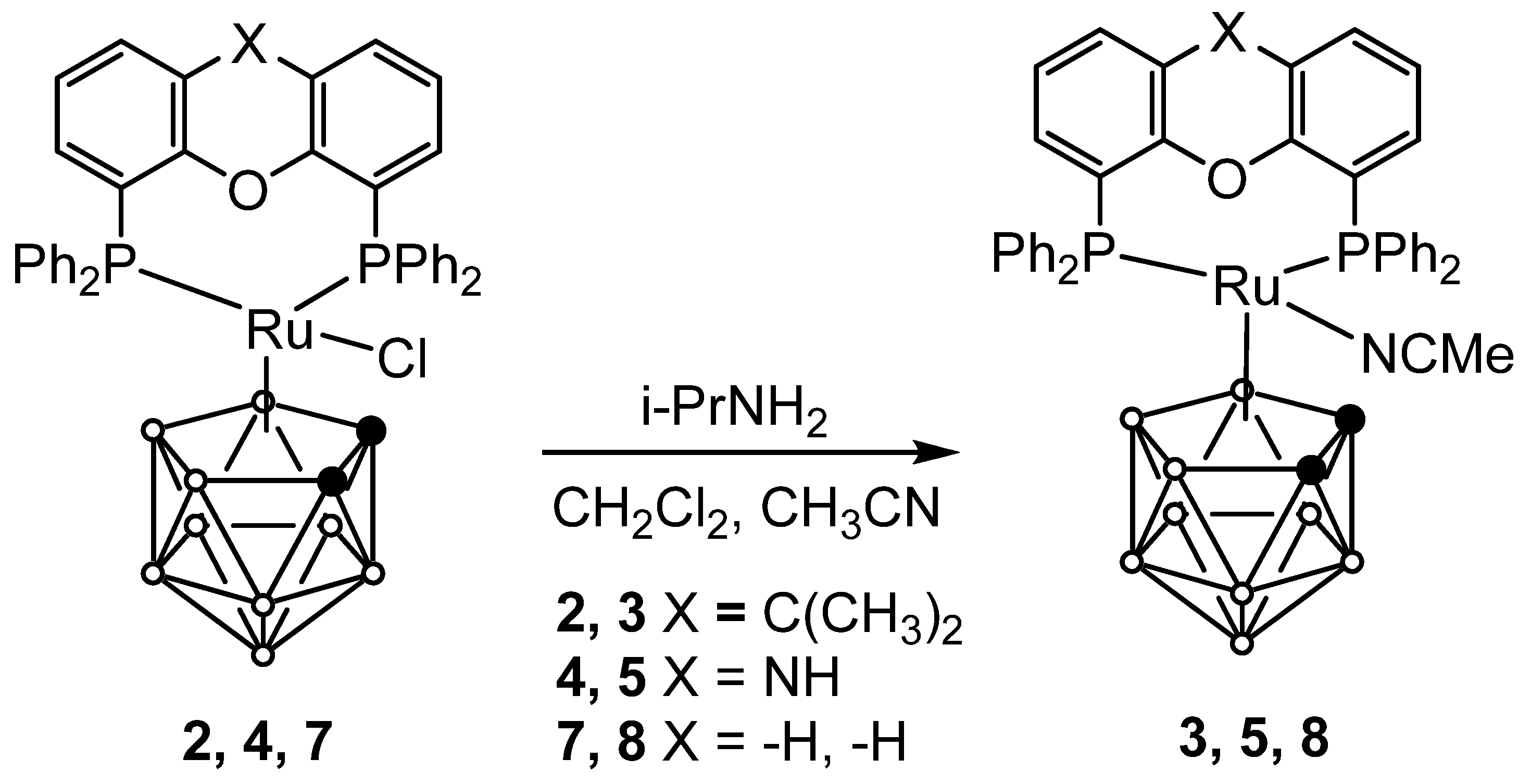
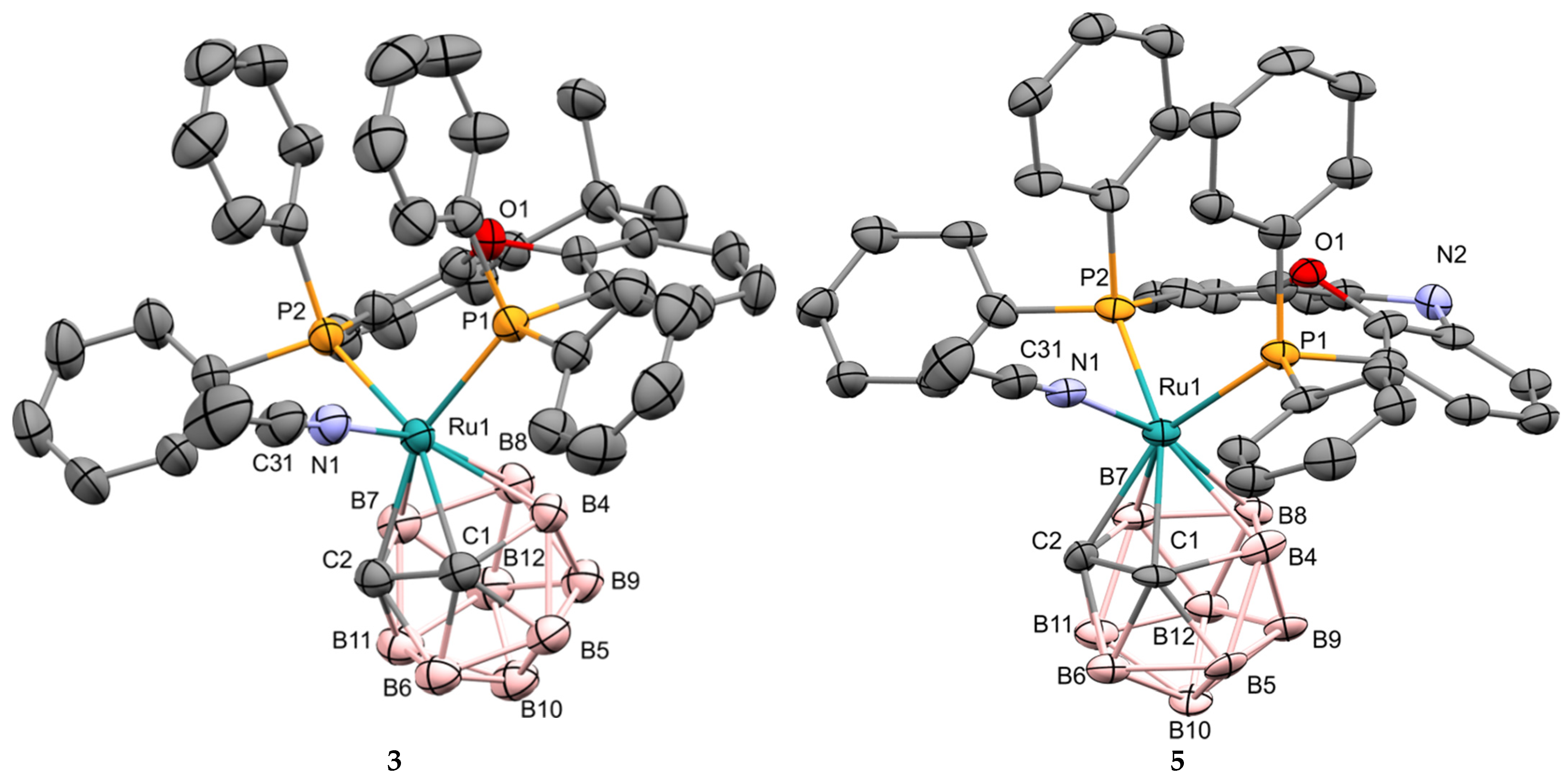

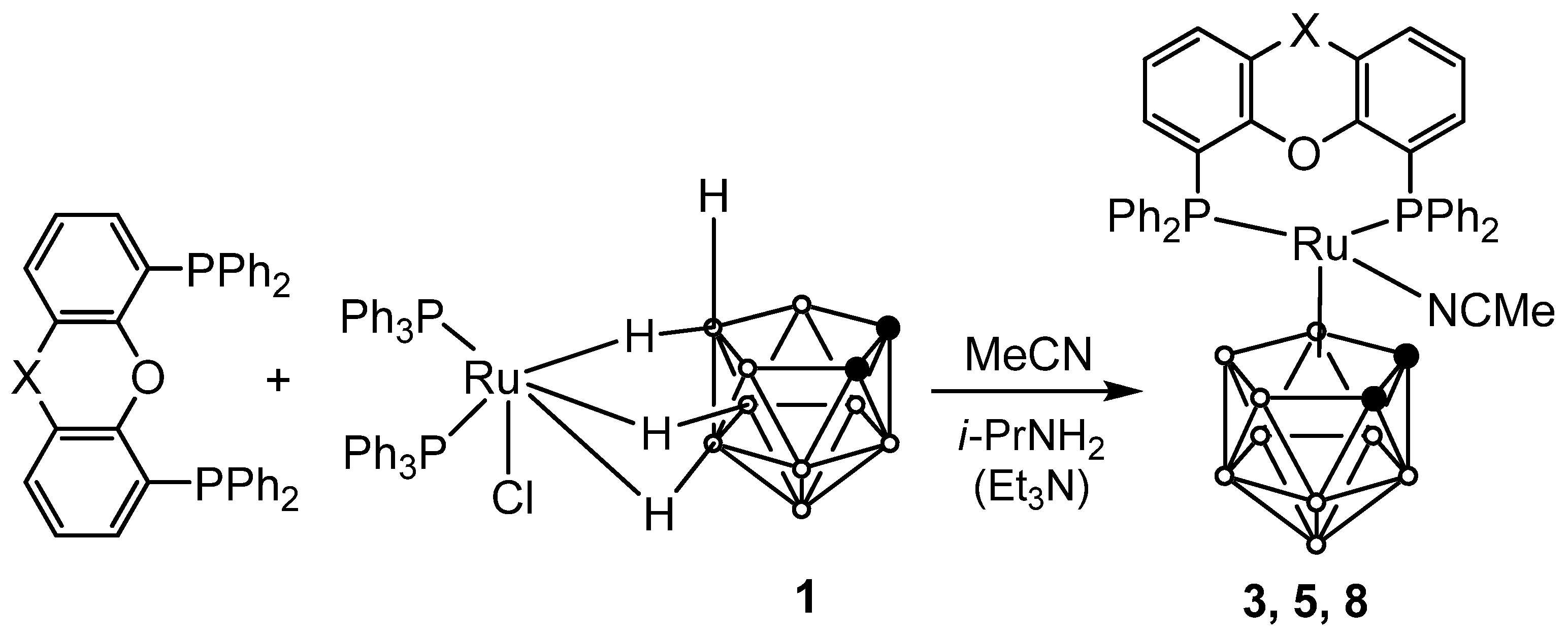
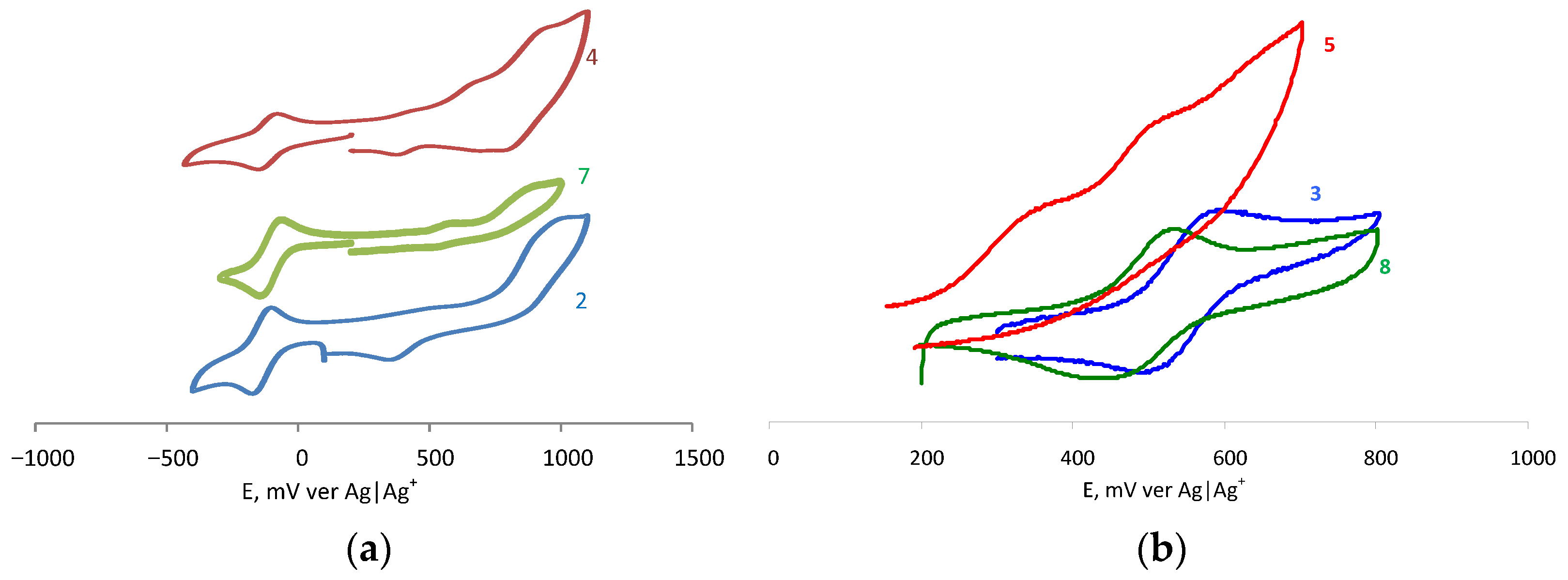
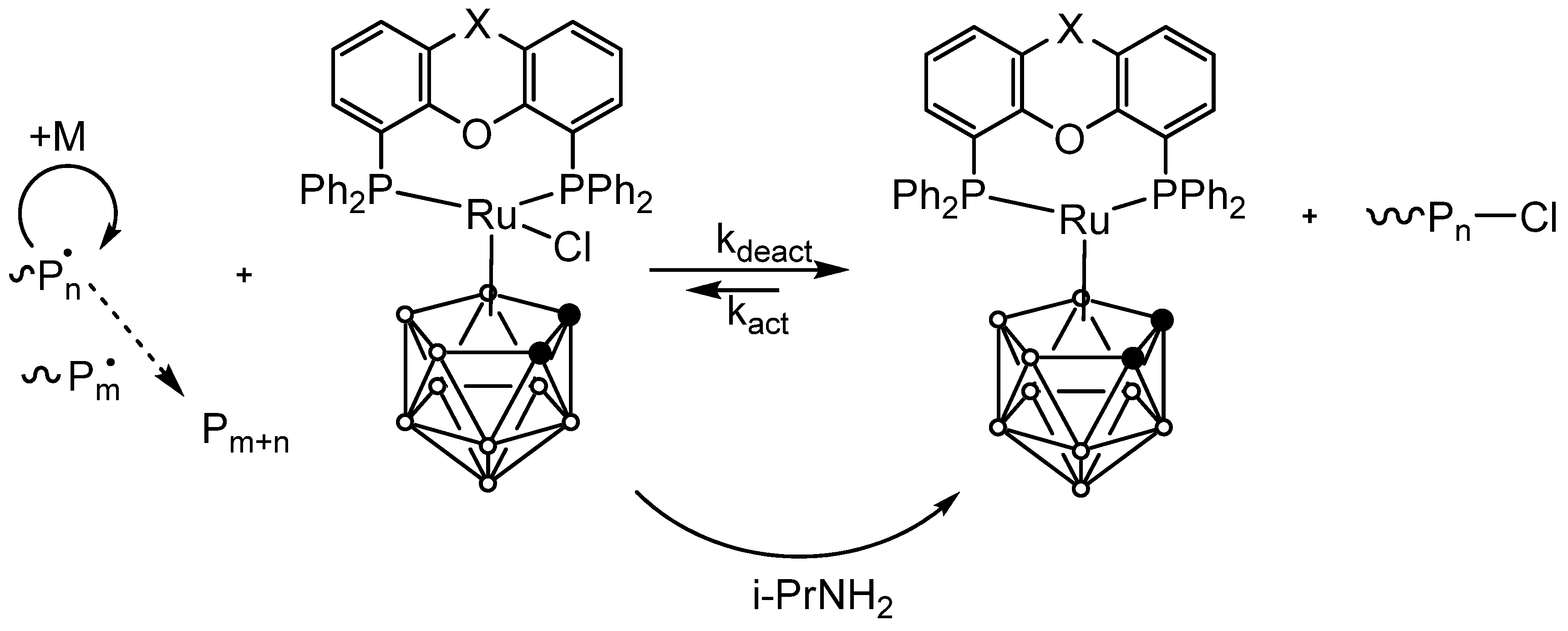
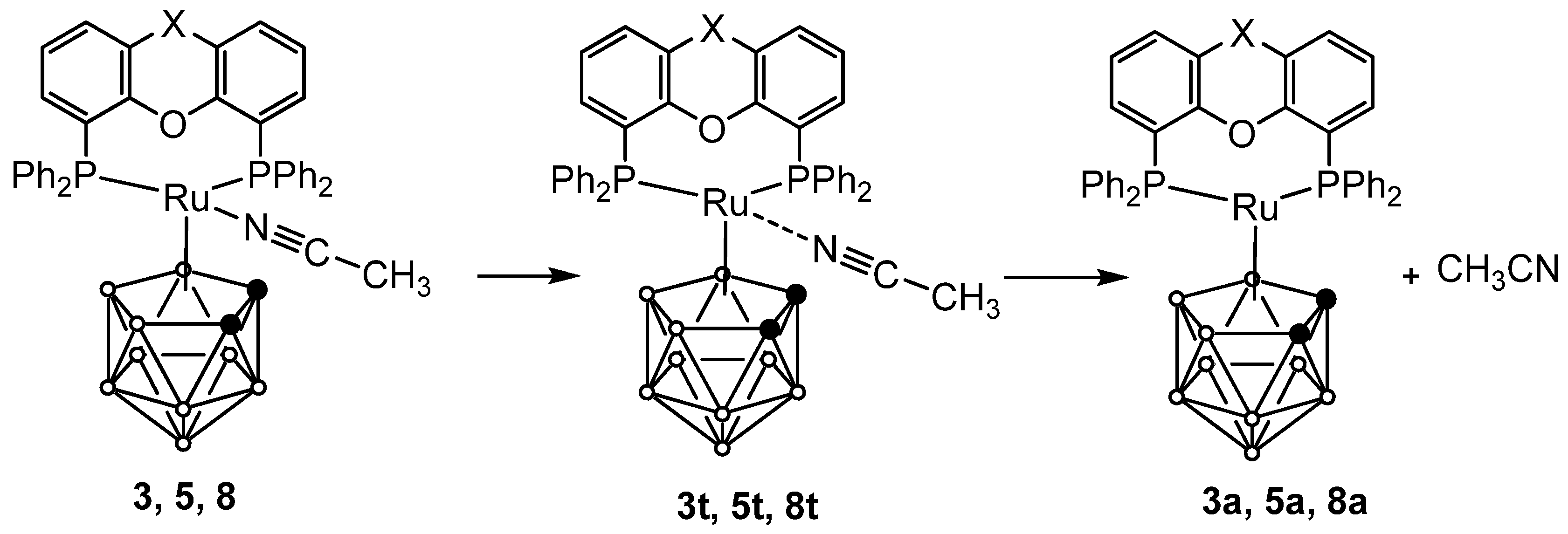
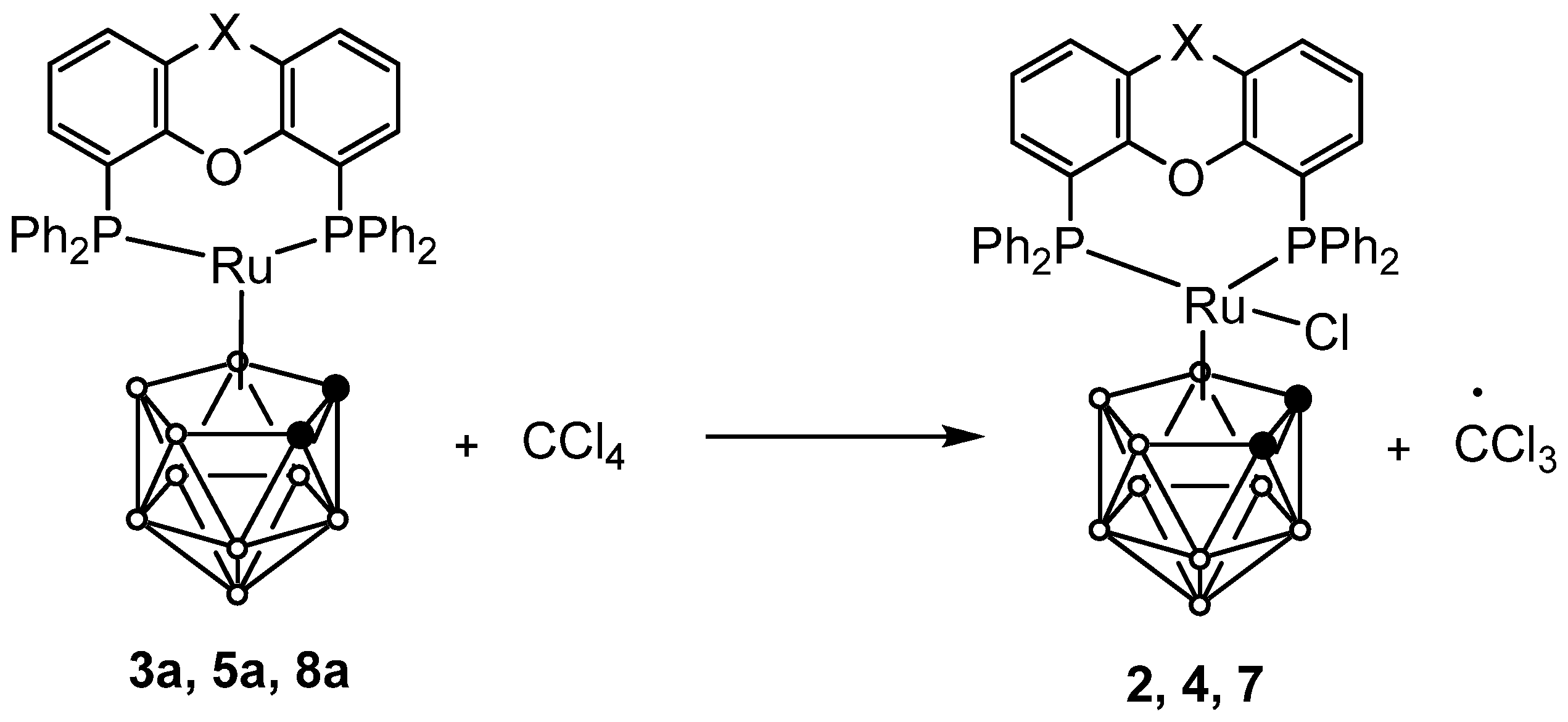
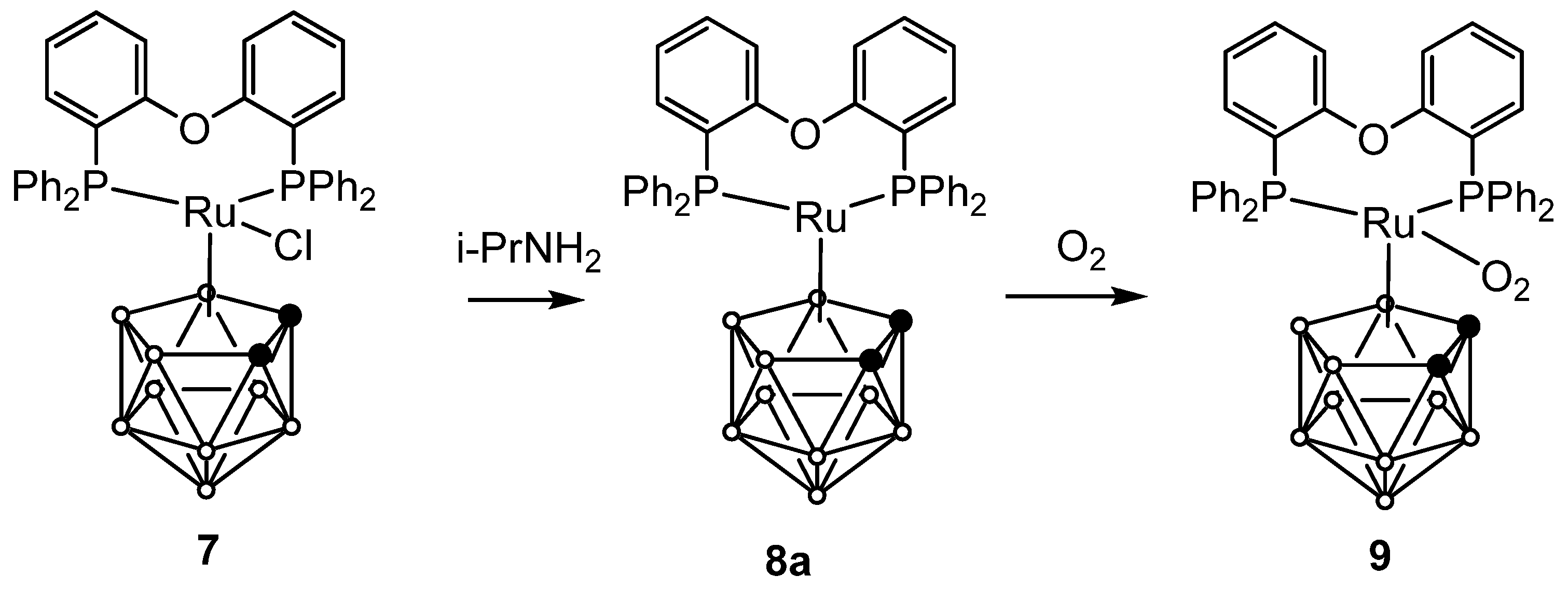
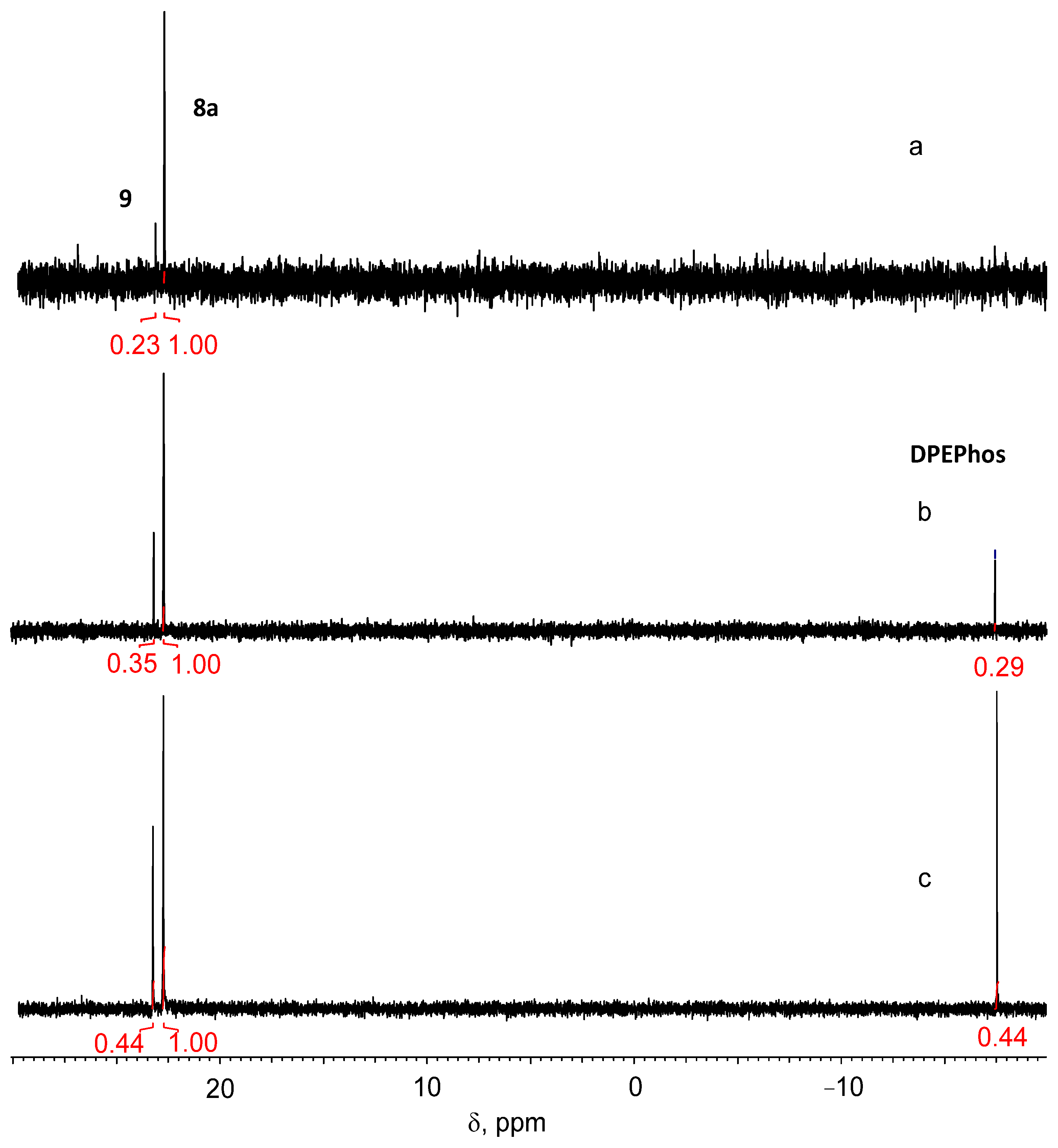
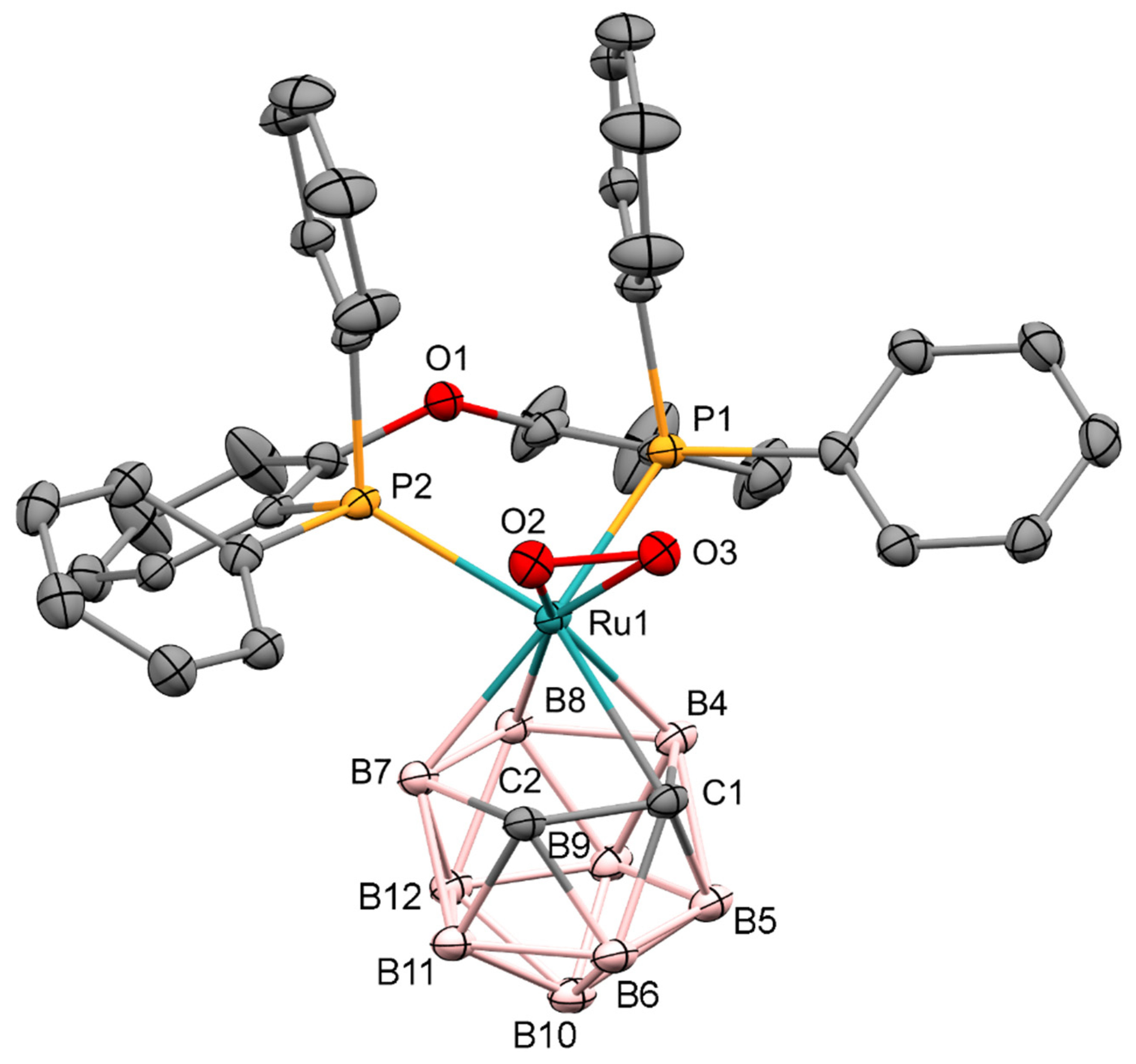
| Parameter | Compound | |||
|---|---|---|---|---|
| 2 | 3 | 5 | 9 | |
| Bond lengths, Ǻ | ||||
| Ru–P1 | 2.4016(6) | 2.3606(6) | 2.374(3) | 2.3629(7) |
| Ru–P2 | 2.4048(6) | 2.3666(6) | 2.358(3) | 2.3657(2) |
| Ru–Cl/N | 2.3831(7) | 2.064(2) | 2.064(10) | - |
| Ru–O1 | 3.5388(17) | 3.5028(16) | 3.456(8) | 3.6910(18) |
| Ru–O2 | - | - | - | 2.0399(18) |
| Ru–O3 | - | - | - | 2.0427(18) |
| Ru–C1 | 2.246(3) | 2.206(2) | 2.229(10) | 2.286(2) |
| Ru–C2 | 2.248(3) | 2.212(2) | 2.209(12) | 2.393(2 |
| Ru–B8 | 2.259(3) | 2.293(3) | 2.295(14) | 2.278(3) |
| Ru–B7 | 2.248(3) | 2.242(3) | 2.258(13) | 2.271(3) |
| Ru–B4 | 2.245(3) | 2.243(3) | 2.255(13) | 2.271(3) |
| C1–C2 | 1.604(4) | 1.631(3) | 1.643(15) | 1.595(4) |
| O2–O3 | - | - | - | 1.405(3) |
| Valence angles, deg. | ||||
| P1–Ru–P2 | 94.51(2) | 95.58(2) | 96.08(11) | 92.47(2) |
| P1–Ru–Cl/N | 91.65(2) | 89.99(6) | 91.9(3) | - |
| P2–Ru–Cl/N | 92.47(2) | 89.79(6) | 88.4(3) | - |
| Transition | Compound | ||||||
|---|---|---|---|---|---|---|---|
| 2 | 4 | 7 | 3 | 5 | 8 | ||
| M−/M | Epa, mV | −298 | −280 | −274 | - | - | - |
| Epc, mV | −369 | −360 | −350 | - | - | - | |
| E1/2, mV | −333 | −320 | −312 | - | - | - | |
| Epa−Epc, mV | 71 | 80 | 76 | - | - | - | |
| M/M+ | Epa, mV | 800 | 471 2 | 702 | 331 | 360 3 | 395 |
| Epc, mV | - | - | - | 242 | - | 300 | |
| E1/2, mV | - | - | - | 286 | - | 348 | |
| Epa−Epc, mV | - | - | - | 94 | - | 94 | |
| Complex | Type | Conversion | Mn × 10−3 | Mw/Mn | Mn,theor × 10−3 |
|---|---|---|---|---|---|
| 2 | 17-e | 61 | 21.4 | 1.5 | 24.4 |
| 3 | 18-e | 94 | 27.2 | 1.6 | 37.6 |
| 4 | 17-e | 70 | 23.5 | 1.7 | 28.0 |
| 5 | 18-e | 68 | 25.5 | 1.8 | 27.2 |
| 7 | 17-e | 68 | 52.6 | 2.2 | 27.2 |
| 8 | 18-e | 75 | 59.3 | 2.4 | 30.0 |
| Ligand | Energy Change in Reaction, kcal/mol | ||||||
|---|---|---|---|---|---|---|---|
| I | II | ||||||
| ΔrE | ΔrH | ΔrG | E(TS) | ΔrE | ΔrH | ΔrG | |
| Xantphos | 14.1 | 14.1 | 2.6 | 13.7 | 1.8 | 2.2 | 1.6 |
| NiXantphos | 14.6 | 14.6 | 3.1 | 14.0 | 1.0 | 1.4 | 1.0 |
| DPEphos | 8.9 | 8.7 | −1.9 | 15.1 | 15.1 | 15.8 | 13.1 |
| Compound | 2 | 3 | 5 | 9 |
|---|---|---|---|---|
| CCDC No | 2165075 | 2165074 | 2165064 | 2214909 |
| Empirical formula | C41H43B9ClOP2Ru 2 C6H6 | C43H46B9NOP2Ru 2 CH2Cl2 | C40H41B9N2P2Ru CH3CN | C38.75H40.50B9Cl1.50O3P2Ru |
| Molecular weight | 1003.72 | 1022.96 | 867.1 | 867.68 |
| Crystal size (mm) | 0.845 × 0.397 × 0.211 | 0.561 × 0.28 × 0.22 | 0.216 × 0.112 × 0.092 | 0.342 × 0.222 × 0.062 |
| Temperature (K) | 297(2) | 293(2) | 100(2) | 100(2) |
| Crystal system | Monoclinic | Triclinic | Triclinic | Monoclinic |
| Space group | P21/c | P21/c | ||
| a (Å) | 12.2652(2) | 11.3175(4) | 11.6015(14) | 12.9051(4) |
| b (Å) | 22.0922(2) | 11.6877(4) | 12.9626(16) | 17.3631(2) |
| c (Å) | 22.7267(4) | 18.8933(6) | 15.7089(15) | 23.3119(7) |
| β (deg) | 125.048(3) | 83.161(3) | 93.373(9) | 129.448(5) |
| V (Å3) | 5041.5(2) | 2468.62(15) | 2119.4(5) | 4033.6(3) |
| Z | 4 | 2 | 2 | 4 |
| Dcalcd (g.cm−3) | 1.322 | 1.376 | 1.359 | 1.429 |
| linear absorption µ (cm−1) | 4.66 | 6.35 | 4.83 | 6.05 |
| Tmin/Tmax | 0.801/0.925 | 0.809/0.913 | 0.599/1 | 0.92212/1 |
| Reflections collected | 105,544 | 39,245 | 14,935 | 105,579 |
| Independent reflections (Rint) | 15,316 (0.0373) | 12,224 (0.031) | 8323 (0.052) | 8224 |
| Observed reflections (I > 2σ(I)) | 12,773 | 10,834 | 5852 | 7511 |
| Number of parameters | 765 | 571 | 525 | 515 |
| R1 (on F for I > 2σ(I)) | 0.052 | 0.0435 | 0.1179 | 0.0377 |
| wR2 (on F2 for all data) | 0.1343 | 0.1263 | 0.2995 | 0.0930 |
| GOOF | 1.147 | 1.04 | 1.259 | 1.057 |
| Largest diff. peak/hole (e Å−3) | 0.922/−0.637 | 0.821/−0.958 | 3.376/−1.702 | 1.573/−0.848 |
Publisher’s Note: MDPI stays neutral with regard to jurisdictional claims in published maps and institutional affiliations. |
© 2022 by the authors. Licensee MDPI, Basel, Switzerland. This article is an open access article distributed under the terms and conditions of the Creative Commons Attribution (CC BY) license (https://creativecommons.org/licenses/by/4.0/).
Share and Cite
Zimina, A.M.; Somov, N.V.; Malysheva, Y.B.; Knyazeva, N.A.; Piskunov, A.V.; Grishin, I.D. 12-Vertex closo-3,1,2-Ruthenadicarbadodecaboranes with Chelate POP-Ligands: Synthesis, X-ray Study and Electrochemical Properties. Inorganics 2022, 10, 206. https://doi.org/10.3390/inorganics10110206
Zimina AM, Somov NV, Malysheva YB, Knyazeva NA, Piskunov AV, Grishin ID. 12-Vertex closo-3,1,2-Ruthenadicarbadodecaboranes with Chelate POP-Ligands: Synthesis, X-ray Study and Electrochemical Properties. Inorganics. 2022; 10(11):206. https://doi.org/10.3390/inorganics10110206
Chicago/Turabian StyleZimina, Anastasiya M., Nikolay V. Somov, Yulia B. Malysheva, Nadezhda A. Knyazeva, Alexander V. Piskunov, and Ivan D. Grishin. 2022. "12-Vertex closo-3,1,2-Ruthenadicarbadodecaboranes with Chelate POP-Ligands: Synthesis, X-ray Study and Electrochemical Properties" Inorganics 10, no. 11: 206. https://doi.org/10.3390/inorganics10110206





